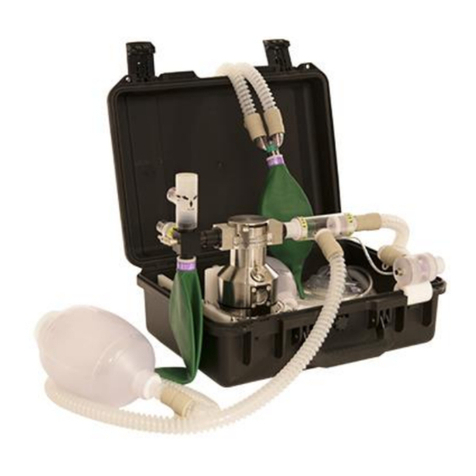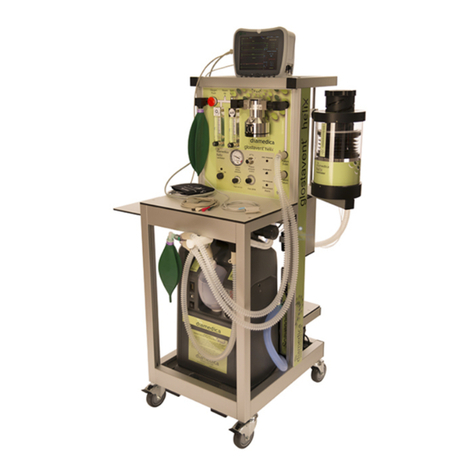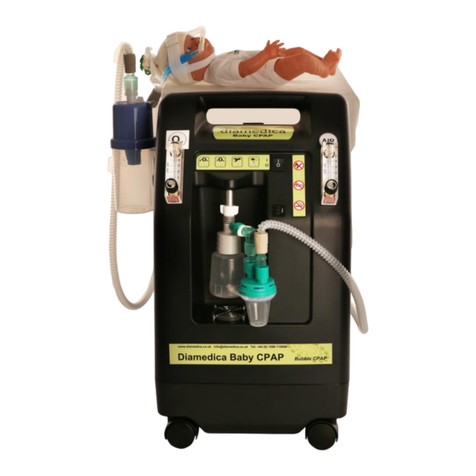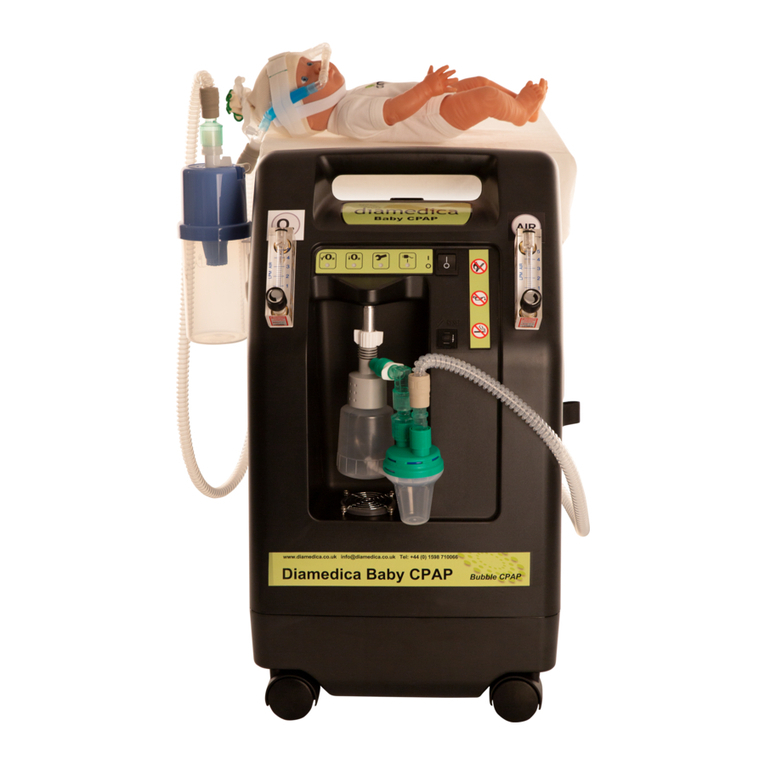Diamedica Portable CPAP User manual

DPCPAP-MANUAL – Rev C© Copyright Diamedica (UK) Ltd 2022 Page 1of 14
Portable CPAP
Instructions for use
Diamedica (UK) Ltd
Grange Hill Industrial Estate
Bratton Fleming, Barnstaple, Devon, EX31
4UH, United Kingdom
Tel: +44 (0)1598 710066
WhatsApp: +44 (0) 7716 503156
Email: support@diamedica.co.uk
Web: www.diamedica.co.uk
Alphamed Consulting Ltd, Knock, Barnaderg, Tuam,
Co. Galway, H54 W220
Revision C 21/06/2022DCN-0162
ENG
1639

DPCPAP-MANUAL – Rev C© Copyright Diamedica (UK) Ltd 2022 Page 2of 14
Read this page first
INTENDED USE
This device is suitable for use in hospital settings with limited resources or in any field or
outreach locations (where a suitable power source may be limited or unavailable) and is
suitable for pre-term babies, neonates and paediatric patients.
Note: Clinical decisions and appropriate patients should be decided by the clinical team on a
case by case basis depending on the patient’s condition.
The Diamedica Portable CPAP provides effective and efficient non-invasive airway pressure
support to neonate and paediatric patients in difficult environments or transport situations.
FOREWORD
This manual is intended to provide guidance on the function, performance and user
maintenance of the Diamedica Portable CPAP. The information given in this manual is correct
at the date of publication.
The policy of Diamedica (UK) Ltd is to continuously improve its products. Changes may be
made to this manual without notice being given.
Users of the Diamedica Portable CPAP must read, understand and follow the guidance given
in this manual before using the system.
THE NEED FOR PATIENT MONITORING
The Diamedica Portable CPAP delivers air (with or without supplementary oxygen) to the
patient and the device should be monitored at all times.
It is essential that the patient’s oxygen saturation and other vital functions are also monitored.
The ultimate responsibility for patient safety remains with the operator.
Observations of the patient must take precedence over machine settings in judging the
condition of the patient.
The system is only intended for use by competent medical personnel

DPCPAP-MANUAL – Rev C© Copyright Diamedica (UK) Ltd 2022 Page 3of 14
Only persons who have read and understood this entire manual and
therefore deemed competent, are authorised to operate this equipment
CONTRAINDICATIONS, CAUTIONS & WARNINGS
CPAP should not be initiated in patients for whom improvement on nasal CPAP is unlikely, or
whose condition requires alternative intervention. These conditions could but are not
restricted to the following.
Known pneumothorax
Upper airway obstruction including croup, epiglottitis, suspected tracheitis
Following traumatic injury
Facial and nasal abnormalities
The use of nasal cannula is contraindicated for patients with nasal atresia or patients with
facial structure deformities that prohibit adequate respiratory support.
Improper selection of size, improper positioning or improper use of nasal cannula may result in
inconsistent CPAP pressures, septal trauma, or necrosis.
Always begin gas flow prior to inserting prongs into patient’s nares.
This device should only be used while the patient is under the continuous, direct supervision of
healthcare professional and frequent observation of prongs position in patient’s nares is
necessary
Cannula tubing can pose a potential strangulation hazard.
Discontinue immediately if skin irritation occurs.
Do not leave unit running while not in use.
If supplementary oxygen is being used:
Ensure suitable flow metering device is used to control input to < 10 L/min.
Do not use in the presence of a naked flame.
Do not smoke in vicinity of unit whilst in use.
The battery supply indicator is for information purposes only, the operator should ensure that
the unit is fully charged prior to initiating support.
The patient circuit should be kept as free form as possible during use and not be coiled as this
can reduce or increase delivered flow and pressure.
Ensure unit is kept free from standing and dripping liquid.

DPCPAP-MANUAL – Rev C© Copyright Diamedica (UK) Ltd 2022 Page 4of 14
DIAMEDICA PORTABLE CPAP MANUAL
1. INTRODUCTION
2. CLEANING, GENERAL MAINTENANCE AND DISPOSAL
3. THE COMPONENT PARTS OF THE PORTABLE CPAP
4. SETTING UP THE PORTABLE CPAP
5. SPECIFICATIONS
6. GLOSSARY

DPCPAP-MANUAL – Rev C© Copyright Diamedica (UK) Ltd 2022 Page 5of 14
1.
INTRODUCTION
CPAP is the application of continuous positive airway pressure throughout the respiratory
cycle. The use of CPAP can assist children with severe respiratory distress.
Worldwide new-born deaths account for more than 40% of the mortality in children under the
age of five years. Respiratory dysfunction is a common cause of death in new-borns and is
often associated with prematurity/low birth weight, infections as well as peri-partum
complications.
The most common causes of respiratory dysfunction in neonates are:
-Respiratory infections
-Surfactant deficiency (respiratory distress syndrome/RDS)
-Meconium aspiration
-Respiratory problems associated with critical illness/severe sepsis
-Congenital heart diseases and congenital pulmonary/thoracic abnormalities are less
common.
-Severe respiratory problems can be associated with persistent pulmonary hypertension
of the new-born.
The introduction of CPAP in a delivery room or a neonatal unit should be an important element
of an improved “neonatal care package” adapted to resource limited contexts.
The Diamedica Portable CPAP is a self-contained portable unit that is powered by internal
battery. This unit generates filtered air to deliver and maintain positive airway support at a set
pressure and flowrate.
Supplementary oxygen can be added either from cylinder oxygen via an appropriate regulator/
flowmeter, or from an oxygen concentrator.
WARNING. Only add supplemental oxygen whilst unit is running and switch off supplemental
supply prior to turning off the unit
The unit uses ambient air as a main gas source which generally contains higher humidity than
concentrator or cylinder gases and there is some additional humidification retained by the
cannula. The gas is delivered to the patient via nasal cannula.
The high flow gas blower in the device generates > 60 litres per minute of gas flow restricted to
appropriate levels by the patient circuit and cannula interface. The delivered flow rate to the
patient being between 5 - 8cmH2O.

DPCPAP-MANUAL – Rev C© Copyright Diamedica (UK) Ltd 2022 Page 6of 14
2.
CLEANING, GENERAL MAINTENANCE AND DISPOSAL
The following guidelines should be reviewed in line with the facility’s own cleaning
procedures and PPE requirements
What You Need:
1. Soap for initial clean.
2. Disinfectant solution: (sodium hypochlorite 0.05% or household bleach, diluted to 0.05%
hypochlorite. The household bleach bottle will indicate its strength, dilution is essential)
Note 5 ml (1 teaspoon) household bleach (5.25% sodium hypochlorite) + 500 ml water=
0.05%.
3. Brush to clean both inside and outside of circuit. All brushes and cleaning implements must
be properly cleaned after use.
4. Drying rack.
Cleaning of the Circuit Tubing:
This should be done after each patient has used the CPAP.
The CPAP circuit which comprises of silicone smoothbore inspiratory and expiratory limbs, and
connections:
1. Remove any gross contamination by first washing all components thoroughly in a detergent
solution (soap and water). Use a clean container and brush the equipment thoroughly
under water to prevent splash and ensure all visible soiling is removed.
2. Rinse with water that has been boiled and allowed to cool to tepid. Let it dry.
3. Wash next in diluted bleach or disinfectant and leave soaking for one hour. Soak all items
together, do not keep use solution for subsequent components. Once used, bleach should
not be re-used or kept in storage, discard after use.
4. Rinse with water that has been boiled and cooled to tepid (rinse also inside, for example,
using a sterile syringe), let it drip dry over the sink, do not leave it coiled on the sink.
5. Check that there is no pooled water in the circuit. Store the circuit and bottle in a clean
plastic bag (labelled and dated). Store in the dry and clean area (separate from a soiled
equipment area).
The above information is supplied as guidance only and is subordinate to each facility’s own
protocol, under which the patient conditions and clinical environment are considered.

DPCPAP-MANUAL – Rev C© Copyright Diamedica (UK) Ltd 2022 Page 7of 14
Filter
Cleaning the CPAP unit
The 300-micron stainless steel mesh dust filter should be cleared of particles before use. This
can be done by directing the inspiratory tube gas flow at the filter.
Warning. Do not operate the unit with the filter blocked with dust.
Warning. Do not operate the unit with the filter removed.
Accessories and spares
A full list of available consumables and spares is available by contacting Diamedica –
support@diamedica.co.uk

DPCPAP-MANUAL – Rev C© Copyright Diamedica (UK) Ltd 2022 Page 8of 14
3.
THE COMPONENT PARTS OF THE PORTABLE CPAP
Note: The Master Power switch is turned off for delivery and will need to be turned on beforeuse and
for charging. Turn it off if the unit is not being used for long periods or for air transport.

DPCPAP-MANUAL – Rev C© Copyright Diamedica (UK) Ltd 2022 Page 9of 14
4.
SETTING UP THE PORTABLE CPAP
Follow the steps below to use the portable CPAP:
1. Switch on the Master Power Switch, thencheck the battery charge always maintain the
battery level above 10 volts.
2. Plug the battery charger into either the mains electricity supply or the vehicle 12volt supply
if not fully charged.
3. Switch on the power switch on the front of the device. A blue light should turn on at the
switch and gas will be generated through the inspiratory outlet.
4. Connect one limb of the circuit to the inspiratory connection and the other limb to the
expiratory connection.
5. Connect the other ends of the limbs to the ‘Y’ connector.
6. Fit the RAM cannula to the ‘Y’ piece.
7. Connect the RAM nasal prongs to the child as below:
8. The flowrate and pressure levels of the Diamedica Portable CPAP are design set.
9. Following use Ensure that unit is switched off at Master power switch (See section a)

DPCPAP-MANUAL – Rev C© Copyright Diamedica (UK) Ltd 2022 Page 10 of 14
Ram cannula
The product is supplied with RAM cannula
Connect the nasal prongs to the child as below:
-Select suitable size cannula. Ideal prongs
size will fill approximately 80% of nares.
Ensure that prongs do not fill nares
completely.
-Attach cannula to single end of Y-Piece
connector. Ensure all joint connections are
properly secured.
-Ensure unit is running and that there is flow from the cannula before fitting to the
patient.
-Insert prongs into patient’s nares allowing a small gap between patient’s septum and
base of prongs always taking care not to exert pressure on the nasal septum.
-Secure cannula in place using suitable method.
-Continually monitor position of cannula during connection to patient.
NOTE: Ensure that patient circuit is as free form as possible and not crushed at any point
causing restriction.
Connect Cannula
connection to 15mm
female connection
on Y-Piece connector
Connect Inspiratory &
Expiratory tubes to 15mm
male connections on Y-Piece
connector
Orientation is not important
The product can also be used with suitable Hudson cannula if required.

DPCPAP-MANUAL – Rev C© Copyright Diamedica (UK) Ltd 2022 Page 11 of 14
5.
Specifications
Portable CPAP
Car Charger
11.5V-13.5V
Mains Charger
95V – 250V
Battery type
Lithium Polymer (8000mAh)
Battery run time
Up to 8 hours
Cannula flow rates
Micro preemie, Preemie, New-born, and Infant, up to 8 L/min
Child Small, Medium, and Large, up to20 L/min
Oxygen supplementation
range
21% - 40%
Maximum pressure
8cmH
2
O (100% nares occlusion)
Operating environment
Temperature 5 - 40ᵒC
Humidity 35% - 90% H
Altitude 79 – 106 kpa
Storage environment
Temperature -10 - +45ᵒC
Humidity 15% - 93% H
Altitude 79 – 106 kpa
Battery charge indicator
Percentage 1% - 100%
Weight
2.8kg
Dimensions
Height 187 mm x Width 243 mm x Depth 103 mm

DPCPAP-MANUAL – Rev C© Copyright Diamedica (UK) Ltd 2022 Page 12 of 14
6. SYMBOLS GLOSSARY
Some or all the following symbols may be used within this manual or found onthe product or packaging
labels. Please familiarize yourself with them:
Symbol
Description
Comment
Manufacturer
Indicates the medical device
manufacturer, as defined in EU Directives
90/385/EEC, 93/42/EEC, and 98/79/EC.
Authorized
representative in the
EuropeanCommunity
Indicates the Authorized
representative in the European
Community.
Date of
manufacture
Indicates the date when the medicaldevice
was manufactured.
Use-by date
Indicates the date after which the
medical device is not to be used.
Batch code
This symbol shall be accompanied by the
manufacturer's batch code. The batch
code shall be adjacent tothe symbol.
Catalogue
number
Indicates the manufacturer's
catalogue number so that the medical
device can be identified.
Serial number
Indicates the manufacturer's serial
number so that a specific
medical device can be identified.
Fragile, handlewith
care
Indicates a medical device that canbe
broken or damaged if not handled
carefully.
Keep dry
Indicates a medical device thatneeds
to be protected from moisture.

DPCPAP-MANUAL – Rev C© Copyright Diamedica (UK) Ltd 2022 Page 13 of 14
Do not re-use
Indicates a medical device that is
intended for one use, or for use on a
single patient during a single procedure.
Refer to the
Instruction Manual
Indicates the user must read the
instructions for use before using the
equipment.
Caution
Indicates the need for the user to
consult the instructions for use for
important cautionary information such
as warnings and precautions that
cannot, for a variety of reasons, be
presented on the medical
device itself.
Non-sterile
Indicates a medical device that has not
been subjected to a sterilization
process.
Class II equipment
Type BF applied part
Recycling symbol
Products with this symbol should not
be disposed of in the bin
The battery recycling
symbol
Chemical symbol for battery type
included beneath
Does not contain or
presence of
natural rubber latex
Indicates that an object
is capable of being
recycled

DPCPAP-MANUAL – Rev C© Copyright Diamedica (UK) Ltd 2022 Page 14 of 14
DIAMEDICA (UK) LTD
Grange Hill Industrial Estate, Bratton Fleming
Barnstaple, Devon, EX31 4UH, UK
Tel: +44(0)1598 710066
Email:support@diamedica.co.uk
www.diamedica.co.uk
Atmospheric pressure
limitation
Indicates the range of atmospheric
pressure to which the medical device
can be safely exposed.
Humidity limitation
Indicates the range of humidity to
which the medical device can be safely
exposed.
Temperature limit
Indicates the temperature limits to
which the medical device can be safely
exposed
Alphamed Consulting Ltd, Knock,
Barnaderg, Tuam, Co. Galway, H54 W220
1639
Table of contents
Other Diamedica Medical Equipment manuals
Popular Medical Equipment manuals by other brands

Getinge
Getinge Arjohuntleigh Nimbus 3 Professional Instructions for use

Mettler Electronics
Mettler Electronics Sonicator 730 Maintenance manual

Pressalit Care
Pressalit Care R1100 Mounting instruction

Denas MS
Denas MS DENAS-T operating manual

bort medical
bort medical ActiveColor quick guide

AccuVein
AccuVein AV400 user manual


















